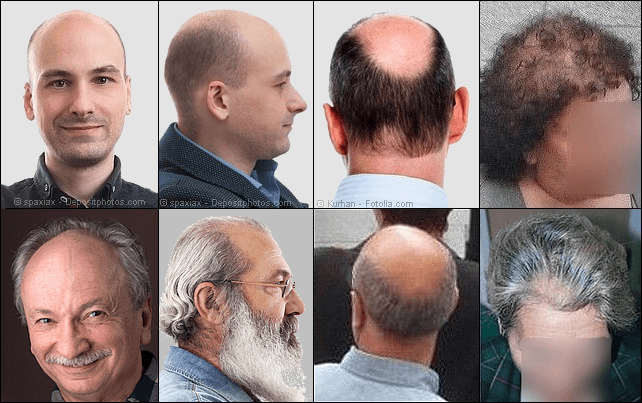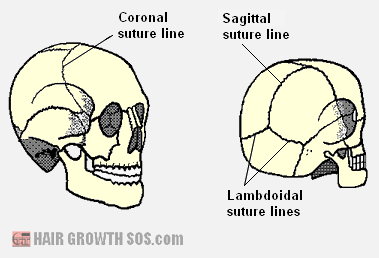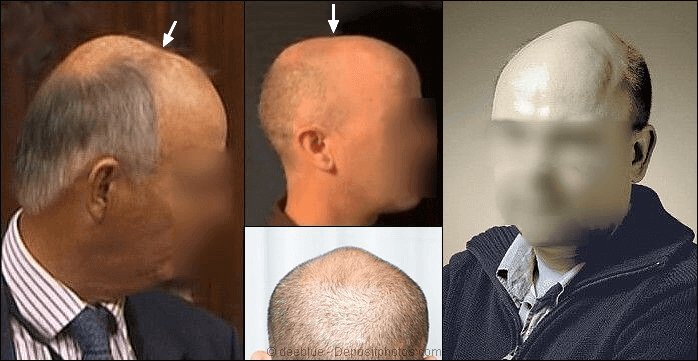- Home
- Skull Expansion
Is Skull Expansion the Real Reason Why You Are Losing Your Hair?
By Paul Taylor
I believe skull expansion is the direct cause of hair loss in men and women. This radical new theory explains how skull bone growth and skull shape changes can start the hair loss process (androgenetic alopecia).
Androgenetic alopecia is by far the most common type of hair loss, affecting a massive 80% of Caucasian men and up to 50% of women (1).
In women, it usually develops
as diffuse hair loss. But for most men, it eventually develops into
the familiar "male pattern baldness" profile.

Given then that it affects so many people, you might have thought this condition is now fully understood.
However, whilst it’s well known that genetics and the hormone dihydrotestosterone (DHT) are definitely involved, the exact mechanism taking place which causes hair follicles to miniaturize and hair loss to develop, remains a mystery.
And so there are still many important questions that the current theory cannot answer. These include:
Q. Which genes actually start the hair loss process?
Q. How can DHT cause both hair loss and hair growth?
(DHT produces body and facial hair growth from puberty onwards) (2).
Q. Why does the familiar male pattern baldness profile develop?
Only skull expansion can provide definitive answers to these questions. And in so doing, fully explain the hair loss process.
What Is Skull Expansion?
Skull expansion (skull bone growth) involves bone remodeling (3).
This
essential biological process is responsible for the growth of your
skeleton as you change from child to adult. And this, of course, includes
your skull, which not only grows in size, but also changes shape.

Once you reach adulthood, bone remodeling then continues throughout life in order to maintain a healthy skeleton.
For some, this simply means keeping the bones strong and healthy. But, for those who suffer hair loss, certain bones of the skull will continue to grow.
This is skull expansion, and is the direct cause of androgenetic alopecia in both men and women. It can also be considered as an exaggeration of the bone remodeling process.
"But don't the skull bones fuse?"
Some people think that the bones of the skull stop growing once you've reached adulthood. But this is not true.
Usually, they’ll simply say "the skull bones fuse" and refuse to accept that skull expansion is what causes this type of hair loss.
Their confusion lies in the fact that the skull bones do indeed fuse.
However, this takes place at the sutures (at the edges where the bones join together) (4). Further bone growth can still occur away from the sutures*.
In the skull diagram below, you can see the sutures as lines which zigzag between each bone. The sutures change from fibrous tissue to bone as you mature. And this is what causes the two adjacent bones to fuse together.

* A 2007 study (5) from Duke University School of Medicine states:
"Using CT scans of 100 men and women, the
researchers discovered that the bones in the human skull continue to
grow as people age."
So, if you have androgenetic alopecia, skull expansion is the real reason why you're losing your hair.
Need convincing?
Just read the following pages and they'll prove to you that skull bone growth is the true underlying cause of this type of hair loss.
1. Your Hair Follicles Are NOT Genetically Programmed for Hair Loss!
Find out why the current theory for male pattern baldness genetics is wrong, and learn which genes are responsible for this type of hair loss.
Male pattern baldness genetics explained.
2. How Can Bone Growth Cause Hair Loss?
Learn how the growth of certain skull bones can cause hair loss in millions of men and women around the world. In other words, learn the actual mechanism taking place that causes hair follicle miniaturization and hair loss to develop.
Two skull shapes are also revealed: one that will develop hair loss, and one that won’t.
How can bone growth cause hair loss?
3. Why Does the "Pattern" in Male Pattern Baldness Develop?
Virtually all men suffer hair loss eventually, and most of them will develop the infamous male pattern baldness profile.
Why?
Read the following page to find out:
Why does the "pattern" in male pattern baldness develop?
4. Why Women Don't Develop Receding Hairlines and Men Do
Certain skull shape characteristics determine whether or not the hairline will recede.
Find out what these characteristics are, and whether you are likely to experience severe hair loss from receding temples. Also learn why most women do not develop receding temples and frontal baldness.
Why men suffer receding hairlines but not women.
5. Extreme Skull Expansion – Extreme Hair Loss!
Learn how extreme skull expansion and hair loss can develop as shown in the photos below. This page also explains why bald spots and patches form at the back of the head.
Bald spots and patches and extreme hair loss.

6. Five Hair Loss Questions Only Skull Expansion Can Answer
This page asks five big questions about hair loss. And then provides all the answers – something the current theory cannot do.
There’s also a free skull expansion ebook that you can read for slightly more in-depth answers.
Five hair loss questions only skull expansion can answer.
|
Like this page? |
|
"Hey Paul, I'd just like to say that your website is terrific and really professional. After reading everything, I definitely agree with the skull expansion theory. Everything adds up like pieces in a puzzle."
Andrew Kelly


Comments and Questions?
Comments and questions about the page you just read are welcome. Just post in the box below. Please also observe the Commenting Rules (opens in a new window).